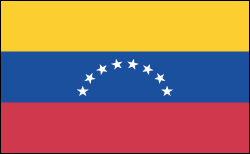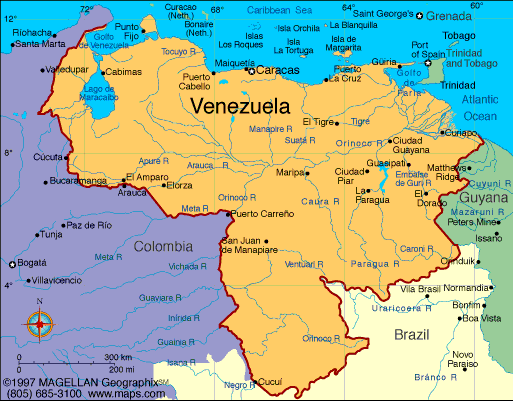VENEZUELA

Geography: Venezuela, a third larger than Texas, occupies most of the northern coast of South America on the Caribbean Sea. It is bordered by Colombia to the west, Guyana to the east, and Brazil to the south. Mountain systems break Venezuela into four distinct areas: (1) the Maracaibo lowlands; (2) the mountainous region in the north and northwest; (3) the Orinoco basin, with the llanos (vast grass-covered plains) on its northern border and great forest areas in the south and southeast; and (4) the Guiana Highlands, south of the Orinoco, accounting for nearly half the national territory.
Government: Federal republic.
History: When Columbus explored Venezuela on his third voyage in 1498, the area was inhabited by Arawak, Carib, and Chibcha Indians. A subsequent Spanish explorer gave the country its name, meaning “Little Venice.” Caracas was founded in 1567. Simón Bolívar, who led the liberation from Spain of much of the continent, was born in Caracas in 1783. With Bolívar taking part, Venezuela was one of the first South American colonies to revolt in 1810, winning independence in 1821. Federated at first with Colombia and Ecuador as the Republic of Greater Colombia, Venezuela became a republic in 1830. A period of unstable dictatorships followed. Antonio Guzman Blanco governed from 1870 to 1888, developing an infrastructure, expanding agriculture, and welcoming foreign investment.
Gen. Juan Vicente Gómez was dictator from 1908 to 1935, when Venezuela became a major oil exporter. A military junta ruled after his death. Leftist Dr. Rómulo Betancourt and the Democratic Action Party won a majority of seats in a constituent assembly to draft a new constitution in 1946. A well-known writer, Rómulo Gallegos, candidate of Betancourt's party, became Venezuela's first democratically elected president in 1947. Within eight months, Gallegos was overthrown by a military-backed coup led by Marcos Peréz Jiménez, who was ousted himself in 1958. Since 1959, Venezuela has been one of the most stable democracies in Latin America. Betancourt served from 1959–1964, while Rafael Caldera Rodríguez, president from 1969 to 1974, legalized the Communist Party and established diplomatic relations with Moscow.
Venezuela benefited from the oil boom of the early 1970s. In 1974, President Carlos Andrés Pérez took office, and in 1976 Venezuela nationalized foreign-owned oil and steel companies, offering compensation. Luis Herrera Campíns became president in 1978. Declining world oil prices sent Venezuela's economy into a tailspin, increasing the country's foreign debt. Pérez was reelected to a nonconsecutive term in 1988 and launched an unpopular austerity program. Military officers staged two unsuccessful coup attempts in 1992, while the following year Congress impeached Pérez on corruption charges. President Rafael Caldera Rodríguez was elected in Dec. 1993 to face the 1994 collapse of half of the country's banking sector, falling oil prices, foreign debt repayment, and inflation. In 1997, the government announced an expansion of gold and diamond mining to reduce reliance on oil.
Government: Federal republic.
History: When Columbus explored Venezuela on his third voyage in 1498, the area was inhabited by Arawak, Carib, and Chibcha Indians. A subsequent Spanish explorer gave the country its name, meaning “Little Venice.” Caracas was founded in 1567. Simón Bolívar, who led the liberation from Spain of much of the continent, was born in Caracas in 1783. With Bolívar taking part, Venezuela was one of the first South American colonies to revolt in 1810, winning independence in 1821. Federated at first with Colombia and Ecuador as the Republic of Greater Colombia, Venezuela became a republic in 1830. A period of unstable dictatorships followed. Antonio Guzman Blanco governed from 1870 to 1888, developing an infrastructure, expanding agriculture, and welcoming foreign investment.
Gen. Juan Vicente Gómez was dictator from 1908 to 1935, when Venezuela became a major oil exporter. A military junta ruled after his death. Leftist Dr. Rómulo Betancourt and the Democratic Action Party won a majority of seats in a constituent assembly to draft a new constitution in 1946. A well-known writer, Rómulo Gallegos, candidate of Betancourt's party, became Venezuela's first democratically elected president in 1947. Within eight months, Gallegos was overthrown by a military-backed coup led by Marcos Peréz Jiménez, who was ousted himself in 1958. Since 1959, Venezuela has been one of the most stable democracies in Latin America. Betancourt served from 1959–1964, while Rafael Caldera Rodríguez, president from 1969 to 1974, legalized the Communist Party and established diplomatic relations with Moscow.
Venezuela benefited from the oil boom of the early 1970s. In 1974, President Carlos Andrés Pérez took office, and in 1976 Venezuela nationalized foreign-owned oil and steel companies, offering compensation. Luis Herrera Campíns became president in 1978. Declining world oil prices sent Venezuela's economy into a tailspin, increasing the country's foreign debt. Pérez was reelected to a nonconsecutive term in 1988 and launched an unpopular austerity program. Military officers staged two unsuccessful coup attempts in 1992, while the following year Congress impeached Pérez on corruption charges. President Rafael Caldera Rodríguez was elected in Dec. 1993 to face the 1994 collapse of half of the country's banking sector, falling oil prices, foreign debt repayment, and inflation. In 1997, the government announced an expansion of gold and diamond mining to reduce reliance on oil.

Map of Venezuela
President:
Nicolás Maduro (2013)
Land area: 340,560 sq mi
(882,050 sq km); total area: 352,144 sq mi (912,050 sq
km)
Population (2014 est.): 28,868,486
(growth rate: 1.42%); birth rate: 19.42/1000; infant mortality rate:
19.33/1000; life expectancy: 74.39; density per sq mile: 77
Capital (2014 est.): Caracas, 5,243,301 (metro. area), 2,013,366 (city proper)
Largest cities (2011): Maracaibo, 2.31 million; Valencia, 1.866 million; Barquisimeto, 1.245 million; Maracay, 1.115 million; Ciudad Guayana, 799,000
Monetary unit:
Bolivar
National name: República
Bolivariana de Venezuela
Languages: Spanish (official), numerous indigenous dialects
Ethnicity/race: Spanish, Italian, Portuguese, Arab, German, African, indigenous
people
Religions: Roman Catholic 96%, Protestant 2%, other 2%
Literacy rate: 95.5% (2009 est.)
Economic summary: GDP/PPP (2013 est.):
$407.4 billion; per capita $13,600. Real growth rate: 1.6%.
Inflation: 56.2%. Unemployment: 7.9%. Arable
land: 2.85%. Agriculture: corn, sorghum, sugarcane, rice,
bananas, vegetables, coffee; beef, pork, milk, eggs; fish. Labor
force (2013 est.): 14.01 million; services 70.9%, industry 21.8%, agriculture 7.3%
(2011 est.). Industries: agricultural
products, livestock, raw materials, machinery and equipment, transport
equipment, construction materials, medical equipment, pharmaceuticals,
chemicals, iron and steel products, crude oil and petroleum products. Natural resources: petroleum, natural gas,
iron ore, gold, bauxite, other minerals, hydropower, diamonds.
Exports: $91.78 billion (2013 est.): petroleum and petroleum products, bauxite and aluminum, minerals, chemicals, agricultural products.
Imports: $59.32 billion (2013 est.):
agricultural products, livestock, raw materials, machinery and
equipment, transport equipment, construction materials, medical
equipment, petroleum products, pharmaceuticals, chemicals, iron and
steel products.
Major trading partners: U.S., China, Colombia, Cuba, Netherlands Antilles, India, Brazil (2012).
Communications: Telephones: main lines in
use: 7.65 million (2012); mobile cellular: 30.52 million (2012).
Radio broadcast stations: AM 235, FM n.a. (20 in Caracas),
shortwave 11 (2014). Radios: 10.75 million (1997).
Television broadcast stations: 44 (2014).
Televisions: 4.1 million (1997). Internet Service Providers
(ISPs): 1.016 million (2012). Internet users: 8.918 million
(2009).
Transportation: Railways:
total: 806 km (2008). Highways: total: 96,155 km; paved: 32,308
km; unpaved: 63,847 km (2002 est.). Waterways: 7,100 km; Rio
Orinoco and Lago de Maracaibo accept oceangoing vessels (2011). Ports and
harbors: Amuay, Bajo Grande, El Tablazo, La Guaira, La Salina,
Maracaibo, Matanzas, Palua, Puerto Cabello, Puerto la Cruz, Puerto
Ordaz, Puerto Sucre, Punta Cardon. Airports: 444 (2013).
International disputes:
claims all of the area west of the Essequibo River in Guyana,
preventing any discussion of a maritime boundary; Guyana has expressed
its intention to join Barbados in asserting claims before the United
Nations Convention on the Law of the Sea that Trinidad and Tobago's
maritime boundary with Venezuela extends into their waters; dispute with
Colombia over maritime boundary and Venezuelan administered Los Monjes
islands near the Gulf of Venezuela; Colombian organized illegal
narcotics and paramilitary activities penetrate Venezuela's shared
border region; US, France, and the Netherlands recognize Venezuela's
granting full effect to Aves Island, thereby claiming a Venezuelan
Economic Exclusion Zone/continental shelf extending over a large portion
of the eastern Caribbean Sea; Dominica, Saint Kitts and Nevis, Saint
Lucia, and Saint Vincent and the Grenadines protest Venezuela's full
effect claim.
-------------------- o --------------------
No comments:
Post a Comment